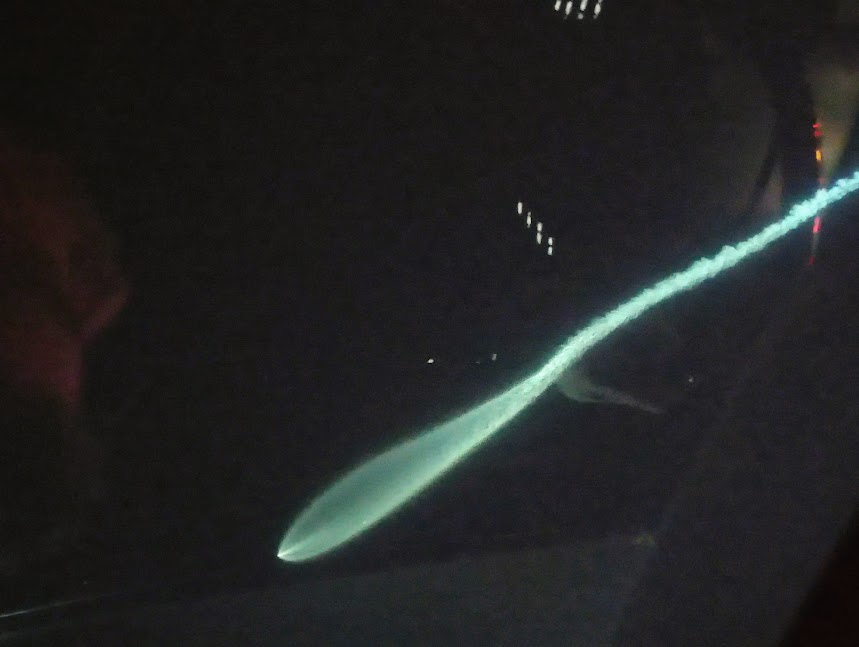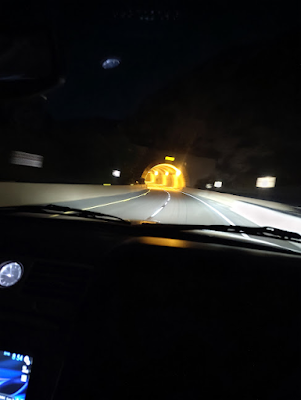Fetching the '46 Plymouth. Part two.
 |
| The car looked even better in person. |
After a thorough test drive, inspection, and interview with the seller, I decided that I definitely wanted the car. My Wife had arranged to have a U Haul trailer available at a nearby rental yard. We called to confirm the reservation, then asked the seller if he would drive the Plymouth back to the Albertson's parking lot for us, which he agreed to do.
It was fun seeing the Plymouth driving in modern traffic. Once the car was back at the parking lot we went to retrieve the trailer in Chino.
It was a journey through the industrial underbelly of the area, there were scores of warehouses, wrecking yards, body shops, transmission repair shops, mechanic's shops, trucking, and tow yards. We passed what looked like a very interesting old wrecking yard. There was a Hudson Hornet on top of the roof, visible from the street! There were parts hanging from the underside of the roof, that were behind the razor wire fence, but clearly visible from the street.
I might have to look that place up, it might be a good source for parts.
The rental for the trailer was a bit over 300.00, and they allowed three days for the rental.
We returned to the Albertson's lot to load up the car. I'm not really good at driving with a trailer, but I felt confident as long as I was moving forward. Backing it up still makes me nervous. I've gotten pretty familiar with loading a U Haul car carrier, as I've used them several times. As long as the car is drivable onto the trailer, it's a cinch.
 |
| A good looking combo. I like to see the Navigator doing the job it was built for. |
I had decided to take my Navigator on this trip, and that was a good idea, It has a much higher towing capacity than my truck. It is 8,600 lbs. 2,000 lbs more than my truck. Plus it has a more powerful V8 engine. Years ago when I picked up my XJS, actually not too far from where I bought this Plymouth, I had used my truck. It was fine on level ground and the stability and braking were also fine, but the V6 engine had it's work cut out for it. Especially going up steep hills.
On that trip I'd also gone up US101 and things were fine until we reached the Cuesta Grade near Paso Robles. That is one steep hill! The truck slowed until I was in first gear creeping along at 25 mph. behind the loaded big rigs. But it made it. The combined total of the XJS and the trailer was approx. 6,000 lbs, right at the limit.
The Navigator was very comfortable on the trip down, and even got respectable fuel economy of a bit over 18 mpg. cruising at 70 mph. when we reached Southern California.
After we loaded up the car and were merging onto the freeway to head home, we heard a car next to us honking the horn and the driver pointed back towards the trailer. It seems that the passenger door of the Plymouth had opened! I pulled over and closed the door, this time I made sure that both were locked before taking off again. Eventually we reached LA and had to deal with heavy rush hour traffic, I just stayed in the right lane and had no problem. Believe it or not, I found most drivers to be very courteous and accommodating of my abrupt late lane changes that I made to stay on course.
We did observe a strange aerial phenomenon while in the West LA area.
 |
| Are aliens arriving? |
It turns out that this was the launch of SpaceX rocket at Vandenburg Air force base. It was a dramatic sight, and luckily it was not followed by the rocket exploding in mid air after take off!
 |
| It had been years since I had made this drive at night. |
This was the sight as we approached the tunnel near Point Refugio, it looked pretty neat at night. I knew we would be arriving at our overnight destination soon,
The destination for the night was Solvang. There was plenty of space to park in front of the motel.
 |
| I had plenty of space to make a U-turn and park at the curb. |
As we set off next morning, I was curious about how the Navigator would fare on the Cuesta Grade.
As I started up the grade I put it in a lower gear. By the time I was halfway up, I had shifted to third and the tach showed a bit over 3,000 rpm. with a steady speed of 52 mph. A much more relaxed experience, than with my V6 F150.
The remainder of the trip was uneventful, at least for us.
There was an extreme traffic back up as we passed north of Salinas on the portion of US101 that was two lanes and hilly. Traffic slowed to a crawl and I was running low on gas. Luckily there was a station right off the next ramp.
We tried to find an alternate route and exited the freeway, but we ended up rejoining the freeway after only five or so miles. It seems that everyone else had the same idea.
 |
| Obviously their trip was not uneventful! |
I had kept my speed down to 55-60 mph. in the hills, but let it creep up to 65 mph. occasionally on level ground. We had passed through LA in the middle of rush hour. I didn't have any problems with traffic and other drivers, they could obviously see that I was towing a car.
During the trip back home I spent a lot of time thinking about what it will be like to drive the Plymouth. From what I've read, the manufacturer claimed the top speed to be 80 mph. That was plenty when the speed limits on open highways seldom exceeded 50 mph. From what I've gathered in my research, it should be able to cruise at 60-65 mph. Cars back then were not high powered, but they were geared to use the power that they had. The engines spin a lot higher than those in modern cars, which usually turn less than 1,500 rpm. at 70 mph. The Plymouth reaches it's horsepower peak at 3,600 rpm. and I'd bet that corresponds pretty closely to it's top speed.
The seller told me that he drove the car at 50 mph. all the time, but seldom got on the freeway. That was due to the "hunting" of the bias ply tires which got worse as the speed increased.
I bought the Plymouth because I want to experience what driving was like back in the 1940's. Though it's not ideal for long freeway speed trips, I want to try to recapture the joy that I first experienced riding my Honda 160 motorcycle on local county back roads. The Honda was powerful enough to climb the foothills behind our neighborhood, and it was freeway legal, if barely. It was capable of 70 mph. not ideal for long highway trips, but suitable for short freeway hops out of town, and for connecting back road stretches.
I have no plans to modify or hot rod the car. I want to keep it as original as possible. If I want to drive a fast car, I'll just drive my Mustang GT.
 |
| Taking a break at a highway rest stop. |
The total experience was a pleasant little adventure. The trip totaled 941 miles, The Navigator returned a bit over 18 mpg. on the trip down, with speeds of 70-75 mph. On the return trip from Chino Hills home pulling the trailer the Nav averaged a bit over 13 mpg. with speeds that were an average of 55-60 mph. The total load was 2,210 lbs. for the trailer, with the Plymouth weighing in at approx 3,100 lbs. for a total of 5,200 lbs. The Navigator handled the job easily, and looked great doing it. I enjoy putting it to work doing what it was designed to do. It confirms my belief that a big truck or SUV is a valid transportation choice that can do so many different things so well.
 |
| I stopped at a wide, level street a couple blocks from my house. I always look for an easy place to park. |
Of course I'll be documenting my experiences with the Plymouth on this blog. While it is in quite good shape, there are still some things that will need attending to.
 |
| Safe and sound in my driveway. I'm already developing an attachment to this car. |








No comments:
Post a Comment